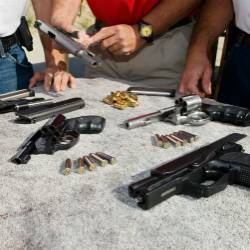
The uncertainties about the causes and frequency of mass shootings are a direct reflection of the country’s lack of timely and accurate data on gun violence. Although the Centers for Disease Control and Prevention (CDC) reports statistics on the number of deaths due to firearms as part of its Vital Statistics Cooperative Program, it takes so long for he Centers to collect and validate data from state death records that the most recent figures are over two years old, much too great a lag to detect an outbreak in firearm-related mortality.
The primary reason the CDC has not established a real-time surveillance program for gun-related mortality is the US Congress who, feeling the pressure of the NRA, has prohibited the center from any research on firearms since 1997. While President Obama’s 2014 budget allocates $10 million for research on firearms, this sum seems insignificant when one considers that the range of annual government funding for leading chronic diseases is 20- to 200-fold this amount. But no number makes the insufficiency of the sum more stark than the $10 million dollars the NRA earned in the first 6 months after Newtown, owing to an intensive recruitment campaign.
When political will has stood with arms crossed before a Goliath, US citizens have a history of taking the role of David in the interest of the public’s health. Frustrated by the intransigence of the gun bloc in Washington, more and more individuals are reframing the gun debate as a matter of public health rather than politics and are launching grassroots efforts to move the conversation on firearms forward. As with the public health battles against big tobacco and AIDS, research to clarify the facts about the causes and consequences of firearm use will be a critical piece of these efforts. Michael A. Lewis wrote earlier this year on these pages about a paper in the American Journal of Medicine that sought to compare gun ownership with gun deaths across 27 countries.
A recent example of these new efforts was a project conducted by writers at Slate. Dan Kois and his journalist colleagues wanted to determine if crowdsourcing – volunteerism for the Internet age – could be used to achieve a rapid and accurate census of shootings. With help from a Twitter user, @gundeaths, Kois and his team collated all the online new stories about gun fatalities since Newtown. They then sought help from readers to determine the nature of the event: Where did the shooting occur? How old was the victim? Was the death a homicide or suicide?
After half-a-year of data collection, Kois and his team ended their count last week with several important lessons learned. First, the magazine’s readers were highly responsive but not always consistent in their responses. More than 52,000 individuals participated and each news item was classified by an average of 11 volunteers. Some characteristics of gun deaths got varying results. For example, what some individuals classified as an act of self-defense, others considered a homicide. Such disagreement suggests the crowd may be an unreliable resource when judging human motivation.
The Slate project also identified significant underreporting of gun deaths due to suicide. Suicide accounts for approximately 60% of gun-related death but is rarely reported by news outlets, largely out of concern of encouraging copycat deaths. However justifiable, this trend in journalism makes it a challenge for researchers to get a valid count for total firearm-related mortality using online news. In fact, Kois and his colleagues believe that there census captured only 1/3 of total gun deaths after Newtown.
Because of the bias in their total count, Kois’ team has called their crowdsourcing experiment a failure. Yet in focusing on the problems with their news-based tally of firearm suicides, Kois and colleagues underestimated the achievement of their count of gun deaths due to other causes. When their data (which they have made available to the public) is compared to interim mortality data from the CDC, the count of non-suicide firearm deaths appears to be much more accurate. Thus, crowdsourcing a real-time census of gun-related homicides may be a viable option.
Michael Klein, Chairman and CEO of The Sunlight Foundation, a non-profit whose goal is to increase transparency in government, sees the promise in the Slate writers’ approach. Klein has established a new non-profit, the Gun Violence Archive (GVA) to provide a national tally of gun violence that aims to be more up-to-date and more detailed than any other source on firearm incidents. The GVA will be built with information from multiple sources – news reporting and police reports – to increase the robustness of its numbers. How Klein and his group plan to address the potential reporting biases in their information sources or to get the buy-in from law enforcement agencies is unclear. But the need public health researchers and policy analysts have for a resource like the GVA is too great not to try and face these challenges.
Slate’s experiment highlights the promise for crowdsourcing data on gun violence but also a number of outstanding hurdles. Whether these obstacles can be overcome will be put to the test early in the new year when the GVA is scheduled to make its debut.




